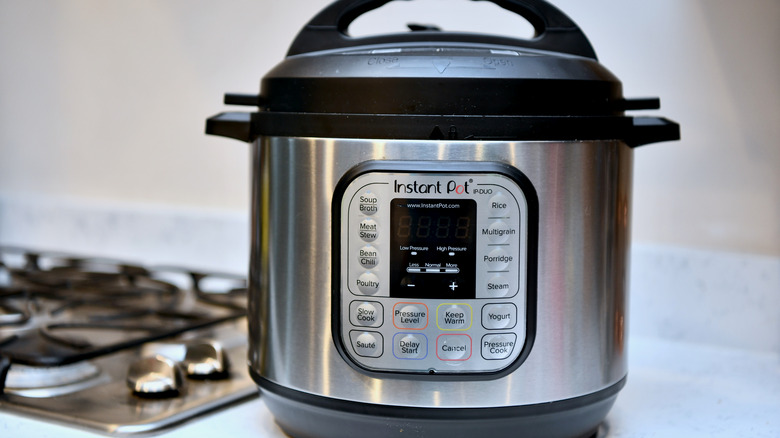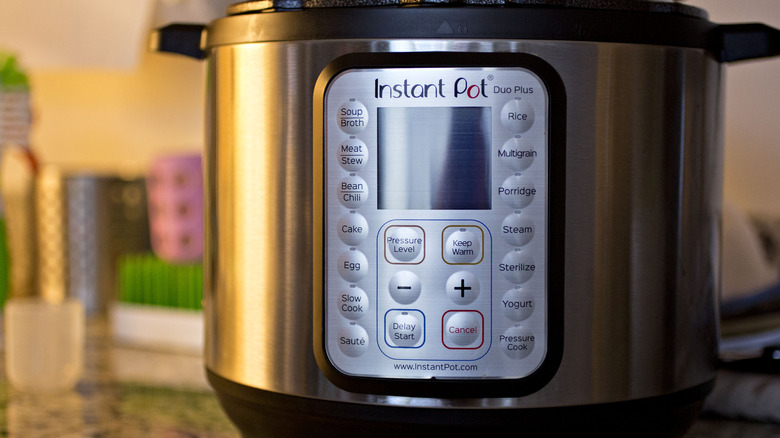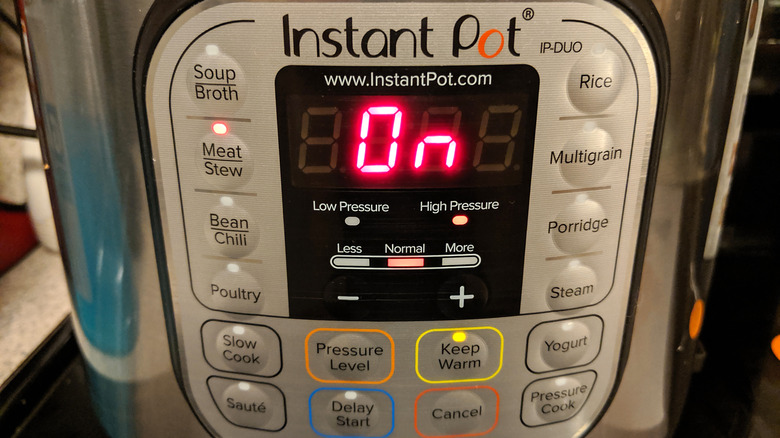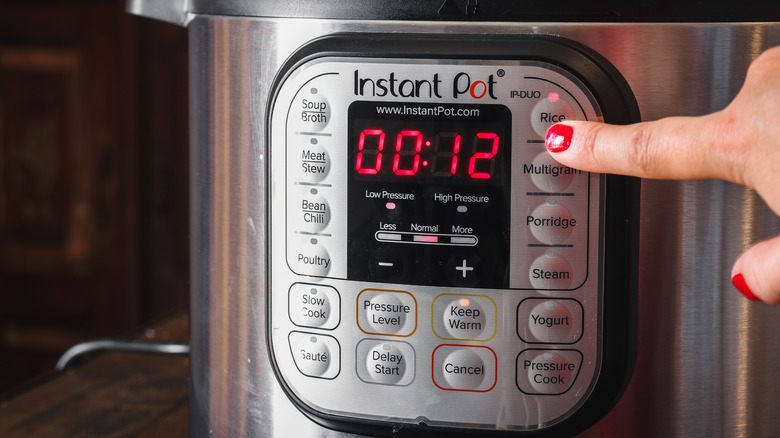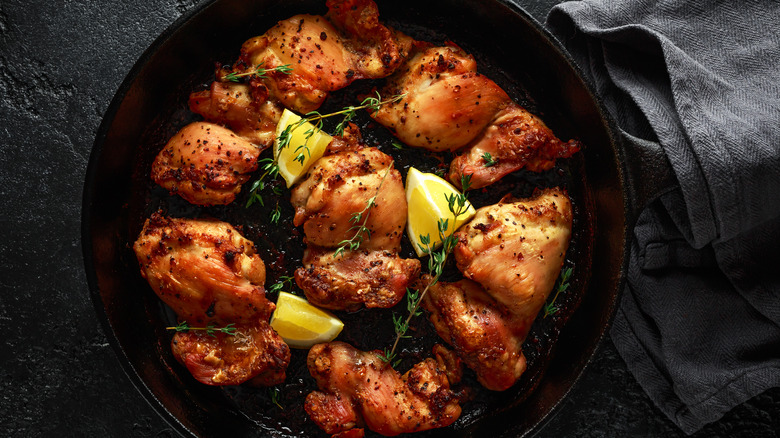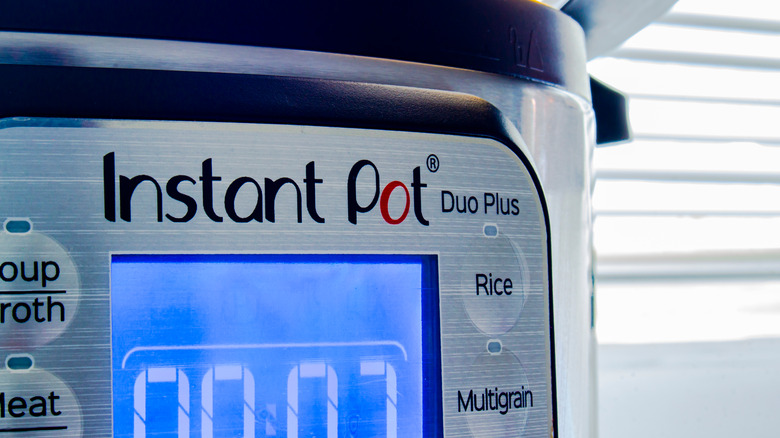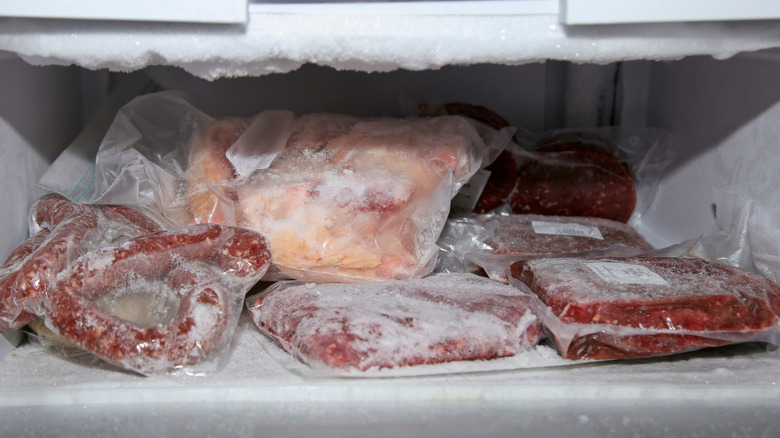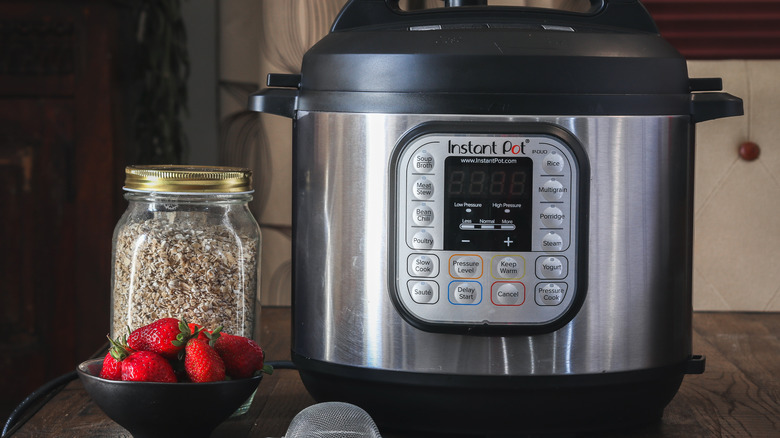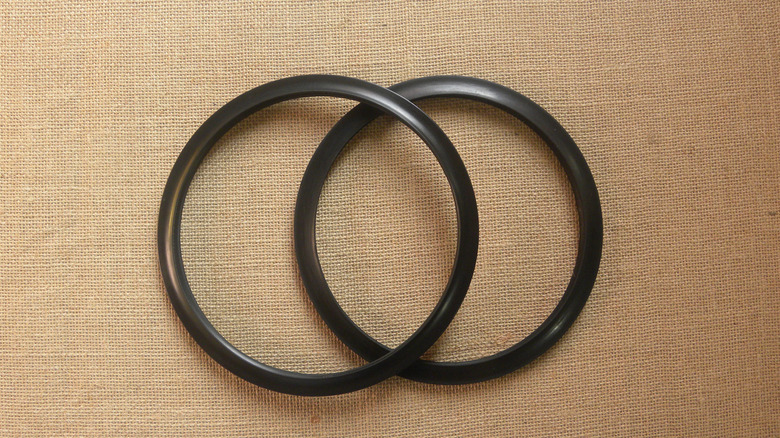Here's Everything You Need To Know About Your Instant Pot
If you haven't yet jumped aboard the Instant Pot bandwagon, we'd say you're a bit behind. After all, this relatively new appliance has seemingly taken the world by storm with its multi-function cooking capabilities that keep home cooks searing, slow-cooking, and pressure-cooking with just a few buttons.
Since its release in 2010, the Instant Pot has replaced other kitchen appliances, helping busy families and solo cooks replicate their favorite recipes at home. Bloggers have written about it, Amazon customers have bought and reviewed it, and social media users have posted about it over and over again. The official Facebook community for Instant Pot alone has more than 3.1 million members as of January 2022.
What's so special about an Instant Pot? You're about to find out, along with other tidbits of important information you need to know about this awe-inspiring appliance before you go and snatch one up for your own kitchen.
How the Instant Pot became an almost instant hit
The founder of the Instant Pot, Robert Wang, sparked the new invention after losing his job as a chief scientist of his own company in 2008. At the time, Wang had young children who he wanted to make sure were eating healthy. Combining his tech experience and desire for healthier diets, Wang developed the idea of the Instant Pot. Wang's priority was to make the Instant Pot an appliance that could replace most others, giving people an easy way to create multiple dishes with just one tool. "[With] Instant Pot, you can actually come home with your groceries in hand and still put the dinner on the table within 30 to 40 minutes," Wang explained in an interview with CNBC.
Once released, the Instant Pot became almost an overnight success. That could be because Wang first began selling the cooker on Amazon, which was exponentially ramping up its own popularity as an online retailer at the time, according to Business Insider. CNBC also notes that Wang invested $300,000 of his own money to get Instant Pot off the ground. About one month after getting started on Amazon, Instant Pot made its first sale; three months in, Wang sold an average of 30 cookers each day on the platform.
An Instant Pot isn't just a pressure cooker
People who don't yet own an Instant Pot might think of the appliance as a pressure cooker, as that's what you might see and hear others referring to them as on blogs, in reviews, and on social media. However, Instant Pot is so much more, which is exactly what founder Robert Wang wanted it to be.
Pressure cookers cook food by building up pressure using steam inside a sealed pot. The pressure raises heat inside the pot and forces liquid through the food as the pressure builds, essentially cooking food in less time than it normally would in other places where heat escapes, like in the oven or on the stovetop.
Not only is Instant Pot a pressure cooker, but it also slow cooks, sears meat, sautés vegetables, cooks rice, bakes, and even makes yogurt. Some Instant Pot models include even more perks, like canning features, sous vide capabilities, and a NutriBoost self-stirring option. In other words, it's an all-in-one appliance that's especially perfect for small kitchens without a lot of counter space to spare.
It had a significant (and scary) recall
In 2018, a few years after Instant Pot had been going strong in sales, blogger-created recipes, and cookbooks, the multicookers came under scrutiny for allegedly posing a fire hazard. According to brand distributor Double Insight, Instant Pot received customer reports of a specific model, the Gem 65, overheating. USA Today notes that, in five of the more than 100 cases, minor property damage was named as an issue resulting from the malfunction.
The brand decided to initiate a voluntary recall in March 2018, citing the reason for the overheating on its website as, "a tooling misalignment during the manufacturing process, which created a gap between the bottom of the inner pot and the top surface of the heating plate in the product. This gap can cause the multicooker to overheat and melt on the underside, posing a fire hazard to consumers." For affected units, Double Insight offered customers a full refund or replacement of their Instant Pot (via Double Insight).
Users should know how to use one safely
While there haven't been any more recent recalls since Instant Pot's overheating issue, that doesn't mean users should use the appliances haphazardly. Any pressure cooker can become a serious danger in the kitchen if not used properly. After buying your new Instant Pot, the best thing you can do for your own safety is to read through its user guide and safety instructions before attempting to cook anything.
The Instant brand also includes several resources on its website for each Instant Pot model, just in case you ever lose the guide that came with yours. The resources include lists of all safety mechanisms added to each model, like safety lid locks that prevent the lid from opening when the cooker is pressurized. Current models also have overheating protection to lower the heat when specific issues are detected, like not enough liquid added to the cooker or if the Instant Pot finds a heat distribution issue.
Although these handy features can prevent several accidents when using a multicooker like the Instant Pot, the user is also responsible for understanding basic appliance safety. According to CNET, users should know how to lock the lid properly before cooking and keep the Instant Pot in a safe area out of the reach of children. Also, check with your user manual to determine how much liquid you should add for the type of food you'll cook.
An Instant Pot saves a lot of time in the kitchen
Instant Pot's founder created the appliance to give home chefs more free time rather than feeling glued to the oven or stove for hours after a long day. In essence, Robert Wang gave them the perfect solution with an all-in-one appliance that can cook foods under pressure and high heat in a fraction of the time that they'd take in the oven or slow cooker with similar — and sometimes better — results.
And if you've ever used one, you know just how much time an Instant Pot really can save. For instance, a soup cooked in a slow cooker can take over six hours. But, if you need dinner on the table in an hour, you can throw your ingredients into the Instant Pot and let it do its thing tenderizing vegetables and moving flavor through every bite.
According to Instant Pot recipe cookbook author Bruce Weinstein, the magic happens because food cooks faster with pressure and high heat. "You can cook a brisket or pulled pork in under an hour," he says via an NBC News interview. "The claims sound outlandish — it reduces cooking time by 70% — but that's because of the steam and the pressure." Writing for The New York Times, author Melissa Clark tried an Instant Pot to see just how fast it could cook. To Clark's surprise, the appliance cooked a pork shoulder to fork-tender perfection in just 90 minutes, lamb shanks in 40 minutes, and spare ribs in just 20 minutes.
Still, it's not 'instant'
While an Instant Pot can definitely cook foods faster than other appliances — especially those that normally would need to sit in a slow cooker for hours to tenderize — the whole process of cooking with one isn't necessarily quick. When you use any of the pressure cooker settings on an Instant Pot, you'll still need to wait for pressure to build up in the pot. According to Instant Pot, that process usually takes 5-10 minutes.
Once your food is finished cooking, you may need to wait several more minutes for the pot to depressurize. This is when the Instant Pot lets out the steam that's built up to cook the food. You can choose to use natural depressurization, during which the Instant Pot releases the steam gradually. Or, opt for Quick Release, which lets the steam come out faster but can also cause a splattered mess in the kitchen. Instant Pot notes that Natural Release can take anywhere from 10-40 minutes, depending on what food you've cooked and how much steam was needed.
The takeaway: Your chicken breasts that take just 10-15 minutes to cook in the Instant Pot still need to pressurize and depressurize, so you're looking at more of a 25-30-minute wait time from start to finish.
Stick with a pan for searing (sometimes)
An Instant Pot is meant to take the place of other appliances and cookware, making it a one-spot stop to deliciousness. While it usually can meet that need, it's not perfect (but what appliance is?). One function some Instant Pot users suggest skipping the sauté function — at least when it comes to searing meats.
Sautéing quickly browns up foods in little time using high heat with a bit of oil or butter. Sautéed vegetables are common in the kitchen, but you can also use this method to brown meat, which is technically known as searing. Although the Instant Pot can sear meat, a traditional hot skillet might be the best tool for the job.
According to Taste of Home, the small surface area of an Instant Pot can limit your ability to get a decent sear on all sides of the meat, especially with larger cuts. One Redditor agreed when responding to another about whether to sear meat first before putting it in the Instant Pot: "If I sear, I do it in a cast iron skillet. Trying to maneuver large hunks of meat in the [Instant Pot] is cumbersome."
No peeking allowed
If there's one thing you might be tempted to do with your Instant Pot but shouldn't, it's peeking at your yummy food that's brewing in the pot. On any of the pressure settings, your food relies on the buildup of pressure and heat to cook everything quickly. Therefore, it's important that, once you start the process, you're able to let it continue until it's done.
Instant Pot recommends completing an initial test run with your cooker before putting any food in it to familiarize yourself with how it works and feel more comfortable setting it up. The website also has helpful cooking tables to give you an idea of how long to expect each type of food to take. For example, frozen lobster takes just 3-4 minutes to cook, but dry soy beans can take as much as 45 minutes in your Instant Pot.
If you're in a hurry and need to speed things up a little, remember that the Quick Release setting is there to make the depressurization process move quicker. Try it out during your initial test run to see how it works.
Instant Pot authorizes and recommends specific cookbooks
Browse through Amazon for a few minutes and you'll probably find dozens, if not hundreds, of cookbooks dedicated to Instant Pot recipes. The same holds true for recipes on blogs and Pinterest. While home chefs love whipping up new recipe ideas for the Instant Pot to share with others, there are actually only a select few cookbooks that Instant Pot endorses and authorizes.
You can find all authorized and recommended cookbooks on the official Instant Pot website. While this doesn't mean that you can't enjoy other cookbooks and recipes you find while browsing the web, you might prefer sticking to the ones that the company has reviewed and approved. In these cookbooks, you can feel confident that the cooking methods, flavors, and cooking times stated in the recipes will most likely work like you expect them to. There's also plenty of variation in the approved cookbooks, including baby food recipes, desserts, paleo eating, and Indian-inspired recipes.
Forget to thaw your food? No problem
One of the best features of an Instant Pot is that there's no need to thaw your food before cooking it. That's great news for busy people who don't always remember to plan out the next day's meal ahead of time. Just take the food out of the packaging, place it in the pot, add liquid, and watch the magic happen. According to The Kitchn, frozen soup is one of the best meals to cook in your Instant Pot because it's quick to heat up and doesn't require a bunch of extra liquid. Frozen meats, poultry, and fish are also great candidates, especially when cooking in a broth or sauce.
Remember, though, that cooking food from frozen in your Instant Pot will differ from cooking thawed food. You'll need to add extra cooking time to most things, and pressurization will take longer because your Instant Pot needs to work harder to build that heat. Most importantly, use a digital meat thermometer to check the internal temperature of any meat, just to make sure it's cooked thoroughly before serving (via Food Network).
An occasional Instant Pot deep-clean is necessary
Like any kitchen appliance that's used to cook food, Instant Pots should be cleaned after every use. However, the Instant Pot has a lot of nooks and crannies that a typical wash may not reach, like where the lid fits into the outer pot and under and around the pressure seal. Because you can use this multicooker for a variety of foods, it's critical to deep-clean your Instant Pot before you switch up your meals to avoid cross-contamination. For the best and safest results, get into the habit of deep-cleaning yours after each use.
To do this, start with the inner removable pot. Clean this using a clean dish towel and dish soap, just like you'd clean most of your dishes. The deep-clean happens with all the more obscure parts of the Instant Pot. Wipe the inside of the outer pot down with a damp dish towel, using a toothbrush or small scrub brush to remove crumbs and stuck-on food, if necessary. You can also use a toothbrush to clean around the rim of the pot, where food tends to hide. Hand wash the silicone ring and anti-block shield and dry them completely. Then, clean the lid. Once everything is sparkly clean and completely dry, put the pieces back together, and your Instant Pot is ready to go.
Get a backup sealing ring
You can find the sealing ring of an Instant Pot around the underside of the lid. The sealing ring creates a tight seal between the lid and the pot, allowing air to stay inside the cooker while heat and pressure build. According to the official Instant Pot website, the sealing ring is also an important part of the overall safety features of the appliance, helping it withstand the intense pressure within the pot. Instant Pot recommends replacing this seal every 12-18 months, at minimum, but frequent users might opt for 6-12 months instead.
Therefore, consider keeping an extra or two on hand, just so you can have it when you need it. Instant Pot sells a regular clear seal, just like the one most Instant Pots come with. However, you can also grab a red-and-blue two-pack, using one for savory and one for sweet foods Since the seal can absorb odors over time, Switching between the two rings is best to avoid scents and flavors from last night's pot roast seeping into tonight's pressure cooker brownies.
Depressurizing an Instant Pot can get messy
Before opening the lid of your Instant Pot when using any pressure cook setting, it needs to go through the depressurization process to release its steam and pressure. Usually, the natural release process yields cleaner results than the quick release process, but both can get a little messy in the kitchen.
Homeowners without an island or extra counter space away from cabinets might worry that the splatters from steam will harm their cabinets. It's a valid claim, according to The Kitchn, which notes that regular Instant Pot depressurization could do some damage, like warping the wood, if you don't take a few steps to prevent it. Immediately wiping off any splatters and moisture from your kitchen surfaces is the best way to avoid adverse effects. To prevent as much splatter as possible, The Kitchn recommends turning the Instant Pot away from your cabinets so that the pressure valve also faces the opposite direction. Whatever you do, don't cover the pressure valve with anything; the Instant Pot needs it open to release pressure, and covering it poses a serious safety hazard.
Size matters
If you're considering an Instant Pot, but you're still on the fence about which one to buy, first decide which size you need. The Instant Pot is currently available in three sizes: 3, 6, and 8 quarts. The size refers to the capacity of the inner pot and how much food you can fit into one.
Instant Pot gives an idea of how many people a model can feed on its product pages. The smallest 3-quart options are just right for three servings, so it's ideal for couples, small families, dorm rooms, or cooking side dishes or smaller meals. Moving up to the 6-quart Instant Pot is better for average-sized families or cooking meals in batches, offering space for about six servings. An 8-quart cooker cooks up to eight servings and is ideal for larger batch cooking and meal prepping.
While the 8-quart option might seem like a no-brainer for many, you'll still need to consider how much space you have in your kitchen, especially if you plan to store your Instant Pot on the counter. The few inches of difference in width, height, and length between the 3-quart and 8-quart could feel significant in a cramped kitchen area.
